Story and Photos by Rick Browne, Ph.B.
Editor’s Note: Rick is now Director of Product Reviews for the BBQ website AmazingRibs.com. It is the largest BBQ-related website in the world, with over 1,000 pages of information on the science and art of BBQ, (heavy on the science and technical aspects), and last year received 34,000,000 impressions. Their Pitmasters Club has currently 15,000 paid members/subscribers and could be one of the largest barbecue organizations in the country by the end of the year.
Recipes
Jamaica: Grilled Spicy Shrimp with Lime
Portugal: Grilled Fresh Sardines
Argentina: Cheesy Grilled Vegetables
Well, hopefully I won’t break too many hearts, but I have to tell you that the whole world barbecues. Yup, it’s not just folks in the hills of Kentucky, the bayous of Louisiana, the plains of Texas, or the farmlands of North Carolina (not to mention California, Indiana, South Dakota, Maine, or all the other states).We Americans love barbecue, and in some cases are obsessed to the point of thinking—sometimes out loud, and sometimes quite pointedly—that we Americans are the originators, perfectors, and by far the best practitioners of the barbecue art anywhere on earth.
Everyone, in just about any country that cooks meat/fish/poultry/or game, at one time or another, barbecues. That is to say, they cook their meals over coals, wood, briquettes, gas flame, open fires, or (egad, really?) electric grills. And in many places they grill vegetables and fruit too, another “first” we thought Americans began. Wrong.
The Japanese grill chicken yakitori on sticks of bamboo over coals in a small hibachi grill. Mancunians (as the people who live in Manchester, England, call themselves) grill their wonderfully tasty homemade sausages over lump charcoal. In Brazil they cook beef, pork, chicken, sausage, and lamb on sword-like skewers. The Spanish slow-cook black Iberian pork in 800-degree ovens, while a billion Chinese light up fires to cook pork char siu on long forks.
In Portugal they coat chickens with a fiery piri piri sauce and grill them over open flames or fiery piles of charcoal. Jamaicans rub jerk seasoning into the flesh and slow cook the birds over smoldering pimento wood. Singapore’s dozens of hawker food stands feature the world’s best satay over open fires.
South Africans use hardwoods in their braai stands to char up their boerewors, and Turkish cooks arrange chunks of lamb and eggplant on skewers, charring flavorful shish kepabs for family and friends. A few savvy English restaurants have begun putting barbecues on their back decks to grill up steaks and roasts, so you can get a grilled steak along with those mushy peas.
Of course we have to bring into the conversation the definition of barbecue. To me barbecue means: food cooked outdoors over a heat source, period. Now within that definition are the various aspects of barbecue that everyone fights about: smoking, low & slow barbecue, and grilling. Purists insist that true “barbecue” ONLY means cooking meat for a long time, using smoke, indirectly over a low-temperature wood or charcoal fire. But lots of folks around the world who cook their dinner over flames would disagree.
I think putting a steak right over a hot fire is barbecuing too, as is adding a packet of wood chips for smoky flavor, and cooking over an electric element, a solar-heated grill, a campfire log, or a propane gas flame.
To say barbecue is America’s only indigenous cooking style (and I’ve heard this from several sources) is, at the least, laughable. I don’t think the first cavemen, who braved tasting singed meat from a lightning-struck dinosaur, were Americans, and neither are the millions of folks around the globe who have cooked their meat and veggies over flames throughout the years.
Now, America has a “style” of barbecue that is signatory. I think we slow-smoke, over low heat for a long period of cooking time, more than anywhere else I visited. And we, of all the countries I visited, put much more emphasis on rubs, marinades, flavored woods, and barbecue sauces than just about everyone I met. But those are adaptations, or enhancements if you will, to the art of grilling and barbecue.
On that note, I’d like to point out that we probably go way overboard in our “enhancements.” In Argentina, Uruguay, Brazil, Turkey, Japan, Portugal, Spain, South Africa, Australia, and many other places, the only condiment applied to cooking foods is salt, and perhaps a tiny drizzle of olive oil. And you know what? What comes off the grill tastes wonderful. You can actually taste the meat, fish, or poultry, not spices, herbs, and sauces. Wow, what a concept!
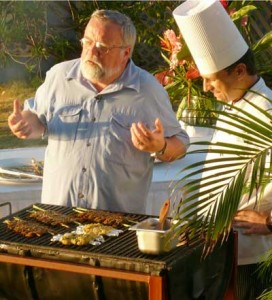
That’s me taping my show in Jamaica with Kai Bechinger, Executive Chef of the Jamaica Inn cooking up jerk shrimp.
Of course much of the world has not adopted our mindless system of feeding cattle corn (not in their design, folks), and adding other chemical aids (many of them from petroleum), and antibiotics to keep them “healthy” while they are artificially and speedily fattened up for slaughter.
Much of the world (especially South America) lets steers and cows eat the food that God designed them to eat: grass! They are pasturized, no not pasteurized: instead of being boiled to remove bacteria as is done to milk, they are fed in grass pastures. In fact, in Uruguay, Brazil, and Argentina they brag (as well they should) that each cow or steer has the equivalent of one entire soccer field’s worth of grass all to his or herself. This makes for a sort of cow paradise—at least until one day they take a field trip in a large truck with a bunch of their buddies, that is.
And of course everyone thinks their barbecue is the best. We agree. It’s just that there is a whole world of “bests” out there, and—try as we might—we just couldn’t taste them all. But we tried awfully hard.
Furthermore, we are informed, the fields are flat, so the animals don’t have to build tough muscle to get to lunch or dinner. A slow amble through a grassy meadow takes them to chow. In the United States, the industrial complex that cattle raising has become keeps them in crowded pens, feeds them food they aren’t used to, and forces them to live on huge, steaming and stinking piles of their own manure for months on end, with nary a blade of grass in sight. Visit a cattle feed lot in the summer and you’ll swear off beef for a month!
To raise your odds of getting chemical-free beef and coming up with a whole new flavor profile, try finding a local farmer and get together with family, friends or neighbors to buy and divide up a side of beef. Beef takes on a whole new taste when bought from these sources, I promise you.
Oh well, I ambled off the track. The point is that we Americans tend to overdo the preparation of foods, including the foods we are about to grill. Try rubbing your steak with a teaspoon of olive oil, sprinkling on some coarse salt, and then cooking it up. You may discover that the taste of beef is okay without the thousands of rubs, hundreds of sauces, and dozens of marinades. Use the dips and sauces on the side, if at all, and then only to enhance the flavor of your food, not to mask, overpower, or obfuscate it. Please.
The travel and worldwide barbecue sampling was for the 6th and 7th seasons of my Barbecue America TV series (subtitled “The World Tour”), and also for my most recent cookbook The Best Barbecue on Earth (Ten Speed Press, Berkeley). We were privileged to visit 26 countries around the world in a mind-numbing and mouth-watering grill odyssey that I will never forget.
Following this story are some of my favorite recipes from around the planet: some fish, some beef, some poultry, and some veggies. In the past 7 years I’ve traveled over 125,000 miles in search of “The Best Barbecue on Earth,” and one thing I’ve learned: there’s a lot of incredible barbecue out there, folks!
There’s always next year.
Hong Kong: BBQ Peking Duck
(with Cold Duck Hoisin Sauce)
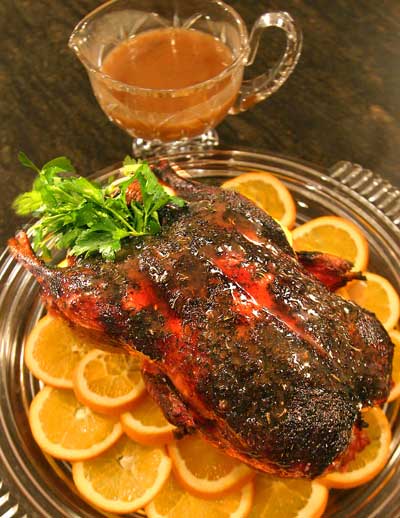
Yes, Peking duck on a barbecue. The secret is dipping the bird in a marinade, which tightens and dries the skin, pulling it away from the fat underneath so the fat can melt off in the heat. Sort of a beer-butt duck kinda thing, but done in a Chinese style and with Chinese hoisin sauce.
1 5- to 6-pound duck
Marinade:
1 cup Cold Duck sparkling wine
1 cup honey
1/2 cup Chinese hoisin sauce
1 teaspoon garlic powder
1 tablespoon powdered ginger
1/4 teaspoon salt
1 16-ounce can of apple juice (or white grape juice)
Wash and dry the duck and place it in a re-sealable plastic bag. Add the marinade, seal bag and refrigerate overnight. The next morning take the duck out of the bag, drain off marinade and reserve, putting it in a covered container and refrigerate. Using twine or butcher string, make a loop through both wings and hang the duck from a cabinet, ceiling fixture or pot rack so the bird is suspended over a pan in the kitchen. Let the duck dry for one day.
Prepare a grill for medium heat (350-450 degrees F.), placing a water pan in center of the BBQ under the grill. Place charcoal or briquettes around the sides of the pan. If using gas, turn off the burner under the pan.
Place the duck on an upright, opened can of apple (or other fruit) juice in one of the many beer-can chicken holders available in stores. While cooking, the juice boils and steams the duck from inside; this method also helps the fat under the skin to melt and drip away. Make sure there is a water pan under the duck in the barbecue so the dripping fat does not fall on hot charcoal, gas, or briquettes and flame up.
Put the reserved marinade in a saucepan and boil for 12 minutes. Cool and use to baste the duck once an hour during the 1 ½ to 2 hours it takes to cook the bird.
When the duck meat reaches an internal temperature of 160 degrees F., remove it from the barbecue. Keep the duck on the can holder and juice, then baste once more with a thick coat of marinade/basting sauce. Remove the can and wrap the duck loosely in foil for about 10 minutes to let it rest.
Cut the duck skin and meat into bite-sized pieces and serve with hoisin sauce, scallion brushes and mandarin pancakes (available in packages at most oriental food stores). To make a scallion brush, take a green onion (scallion) and trim away the roots. Using a sharp knife, trim down the green top of the scallion until it is about 2 inches long. Cut vertically into the bulb end about 1 inch, then make another cut perpendicular to the first so that the scallion is quartered into a four-segmented “brush.”
Use the brush to spread hoisin sauce on the pancakes, add a piece of duck skin and a piece of duck meat, then wrap or fold up the pancake and eat. Voila—BBQ Peking Duck!
Serves 4
Jamaica: Grilled Spicy Shrimp with Lime
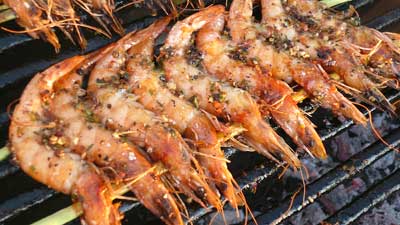
Fresh shrimp should be prepared on the same day they are purchased. To store them before cooking, rinse the shrimp in cold running water and pat dry. Wrap in two to three damp paper towels, place in a re-sealable plastic bag, and refrigerate.
1/2 cup chopped yellow onion
1 jalapeño, stemmed, seeded and chopped
3 tablespoons white wine vinegar
2 tablespoons soy sauce
2 tablespoons canola oil
1/2 teaspoon Krista’s Jamaican Hot Sauce (or your favorite hot sauce)
1/2 teaspoon ground allspice
1/4 teaspoon granulated garlic
1/4 teaspoon cinnamon
1/4 teaspoon kosher salt
1/4 teaspoon freshly ground black pepper
1/8 teaspoon nutmeg
40 large, deveined, unshelled shrimp (about 2 pounds)
2 limes, cut into quarters, for serving
In a food processor or blender, combine onion, jalapeño, vinegar, soy sauce, oil, hot sauce, allspice, garlic, cinnamon, salt, pepper, and nutmeg. Process until smooth.
Put the shrimp in a large re-sealable plastic bag. Pour in the marinade, press out the air, and seal the bag. Shake to coat. Transfer the bag to a large bowl and refrigerate for 1 to 2 hours.
Preheat a charcoal or gas grill to 375 degrees F. Make sure the grill rack is clean, and oil it thoroughly with nonstick cooking spray.
Remove the shrimp from the bag, discard the marinade, and thread the shrimp lengthwise on skewers.
Transfer the shrimp to the prepared grill rack and grill over direct heat, turning skewers only once, until the shrimp are firm to the touch, pink all over, and just opaque, 3 to 4 minutes total.
To serve, transfer to a warm serving platter, squeeze a little fresh lime juice over the shrimp, and serve immediately.
Serves 4-6
Korea: Bulgogi—Barbecued Beef
 It’s important to use very thin slices of steak, as thicker pieces take longer to cook and can be a bit tough with the quick cooking. If you don’t have a very sharp knife and a skill at thinly slicing meat, ask your butcher to do it for you. Or, if you want to do it yourself, put the meat in the freezer for 20 minutes to firm it up, then slice it.
It’s important to use very thin slices of steak, as thicker pieces take longer to cook and can be a bit tough with the quick cooking. If you don’t have a very sharp knife and a skill at thinly slicing meat, ask your butcher to do it for you. Or, if you want to do it yourself, put the meat in the freezer for 20 minutes to firm it up, then slice it.
1 1/2 pounds sirloin or rib-eye steak
6 tablespoons dark soy sauce, plus more for serving
1 tablespoon sugar
2 tablespoons honey
4 tablespoons mirin (rice wine)
3 tablespoons light sesame oil
5 tablespoons minced green onions
4 teaspoons minced garlic
2 teaspoons freshly ground black pepper
1 tablespoon sesame seeds, toasted
2 tablespoons sesame salt
15 to 20 butter lettuce leaves, for serving
Hot sauce, for serving
Preheat a charcoal or gas grill to 375 degrees F. Make sure the grill rack is clean and oil it thoroughly with nonstick cooking spray.
Slice the beef across the grain into 1/8-inch-thick strips. In a large bowl, combine the soy sauce, sugar, honey, rice wine, oil, green onions, garlic, black pepper and sesame salt. Pour the mixture into a re-sealable plastic bag, shaking to combine. Add the beef, seal the bag, shake again to coat the meat, and marinate for at least 4 hours and up to 12 hours.
Drain the meat, discarding the marinade. Transfer the meat, a few pieces at a time, to the prepared grill rack over direct heat, searing until cooked through and browned on both sides, 1 to 2 minutes per side at most. Continue grilling until all the meat is cooked, removing pieces as they are done. Keep the cooked meat warm on a warmed platter, and, when finished, sprinkle the meat with sesame seeds.
Serve the meat with the lettuce leaves, hot sauce, and soy sauce. To assemble, take a leaf in the palm of your hand, add a slice of meat and a sprinkle of hot pepper or soy sauce, then fold the leaf over the meat and enjoy.
Serves 4
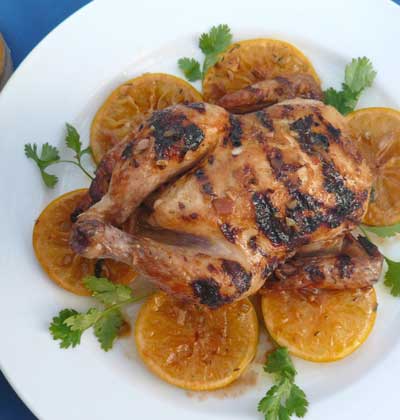
Morocco: Date-Stuffed Chicken
Instead of dates you can use any dried fruit in this dish: apricots, apples, pineapple, mango, prunes, papaya, cherries, etc., or mix a bunch of them together for a very fruity stuffing.
1/2 cup loosely packed chopped cilantro leaves
10 cloves garlic, minced
1 tablespoon ground cumin
1 tablespoon paprika
1/2 teaspoon dried marjoram
1 small chicken
1 cup tawny port wine
1/2 cup olive oil
1/4 cup balsamic vinegar or red wine vinegar
4 tablespoons honey
2 oranges, thinly sliced
2 lemons, thinly sliced
40 pitted whole dates (approximately 1 pound, or 2 cups)
3 tablespoons minced green olives
Salt
Freshly ground black pepper
In a small bowl, combine 6 tablespoons of the cilantro, garlic, cumin, paprika, and marjoram. Rub the mixture generously on the chicken and place in a large re-sealable plastic bag.
In another small bowl, whisk together the port, oil, vinegar, and honey and pour over the chicken and into the cavity. Seal the bag and refrigerate for 8 to 10 hours.
When ready to cook, drain the chicken, wipe away excess marinade, and pour the marinade into a saucepan to boil for 12 minutes.
Prepare a charcoal or gas grill for indirect cooking (it is not necessary to use a drip pan for this recipe). Preheat to 375 degrees F.
Arrange the orange and lemon slices in the bottom of a Dutch oven. Add the chicken, salt and pepper.
Transfer the pot, uncovered, to the grill rack over indirect heat. Lower the grill lid, and cook, basting occasionally, until the chicken is cooked through, or when the internal temperature in the thickest part of the thigh reaches 165 degrees F., about 40 minutes.
Transfer the bird to a warmed platter and cover with aluminum foil until ready to serve. Pour the juices from the pan into a small saucepan, straining out and discarding the lemon and orange slices. Boil, whisking often, until the liquid has reduced to 1/2 cup, about 5 minutes.
Garnish the chicken with the remaining cilantro and serve with the sauce on the side.
Serves 4
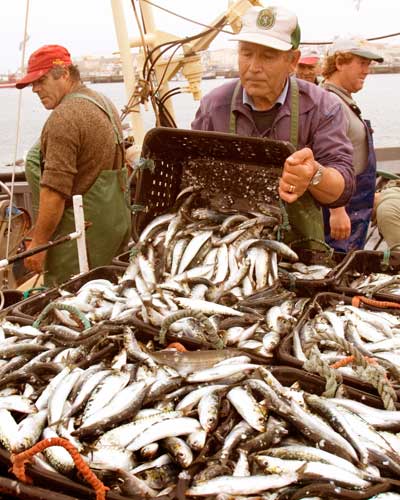
Portugal: Grilled Fresh Sardines
Portuguese sardines are the little guys jammed into a tin can. These are 3 to 4-ounce fish, 6-7 inches long, and are cooked whole on a grill then served on a piece of toasted bread, guts, heads and all. Of course you could clean and de-head them if you wish. Unless you’re lucky enough to have them at your local fish market, whole Portuguese sardines can be ordered online from several sources, including: www.allfreshseafood.com or www.vitalchoice.com or www.prawnco.com.
24 fresh sardines, heads and tails left on
1 cup sea salt
1/4 cup minced garlic
2 tablespoons extra virgin olive oil
Freshly ground black pepper
1/4 cup chopped fresh parsley, loosely packed
Lemon wedges, for serving
Rinse the sardines under cold running water; drain and pat dry with paper towels. Add one-third of the salt to the bottom of a roasting pan, then one-third of the garlic. Transfer half the sardines to the pan and top with half of the remaining salt and garlic. Add another layer of sardines and top them with the remaining salt and garlic. Cover and let stand for 1 hour in fridge.
Prepare a charcoal or gas barbecue for direct grilling at 400 degrees F. Clean and generously oil the grill rack.
Rinse the salt off the sardines and pat dry with paper towels. Brush the sardines with the oil and season with pepper.
Transfer the fish directly to the grill over direct heat or use a fish-grilling basket. Cook the sardines until the skins are lightly charred and the meat is flaky when tested with a fork, 3 to 4 minutes per side.
Using a wide spatula, carefully transfer the fish to a platter, being careful not to break them; garnish with parsley. Serve the fish whole, with lemon wedges on the side.
Serves 4 to 6
Argentina: Cheesy Grilled Vegetables
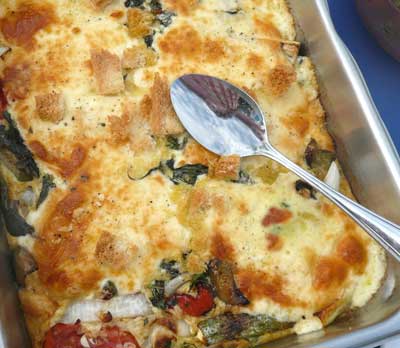 This dish is usually made with sardo, an Argentinian cheese that may be hard to get here in the U. S. You can substitute gruyére, or jack (or for a snappier flavor, a good cheddar).
This dish is usually made with sardo, an Argentinian cheese that may be hard to get here in the U. S. You can substitute gruyére, or jack (or for a snappier flavor, a good cheddar).
6 firm plum tomatoes
1 red bell pepper, stemmed, seeded, and cut into 1/2-inch strips
1 large onion, cut lengthwise into 1/2-inch strips
2 small zucchini, halved lengthwise
2 tablespoons olive oil
1 tablespoon chopped fresh basil
1/2 teaspoon dried thyme
1/2 teaspoon minced garlic
1 teaspoon kosher salt
Freshly ground black pepper
4 large eggs
1/2 cup whole milk
1 cup shredded sardo or gruyère cheese
1 cup fresh breadcrumbs
2 tablespoons grated Parmesan cheese
Prepare a charcoal or gas barbecue for grilling at 350 degrees F. Spray a 10-inch cast iron skillet with nonstick cooking spray and set aside.
Lightly brush the tomatoes, bell pepper, onion, and zucchini with the olive oil. Transfer the vegetables to the barbecue and cook over direct heat, turning several times, until the vegetables start to brown on the edges but are still firm. Keep vegetables separate on the grill, as the zucchini will be finished first, then the tomatoes, then the bell peppers, then the onions. Set aside until cool enough to handle. Remove the skins from the tomatoes and peppers, and cut all the vegetables into 1/2-inch pieces Drain the tomatoes on paper towels.
Transfer the tomatoes, zucchini, onion, and bell pepper to a large bowl. Add the basil, thyme, garlic, salt, and pepper, stirring to combine.
In another large bowl, whisk together the eggs and milk, stir in the sardo cheese, and add the mixture to the vegetables, stirring to combine. Pour into the prepared skillet. Sprinkle the top evenly with the breadcrumbs and the Parmesan.
Transfer the skillet to the barbecue and cook over indirect heat until the edges are browned and the center is set, about 20 minutes.
Let cool to room temperature, cut into wedges, and serve.
Serves 4 to 6









